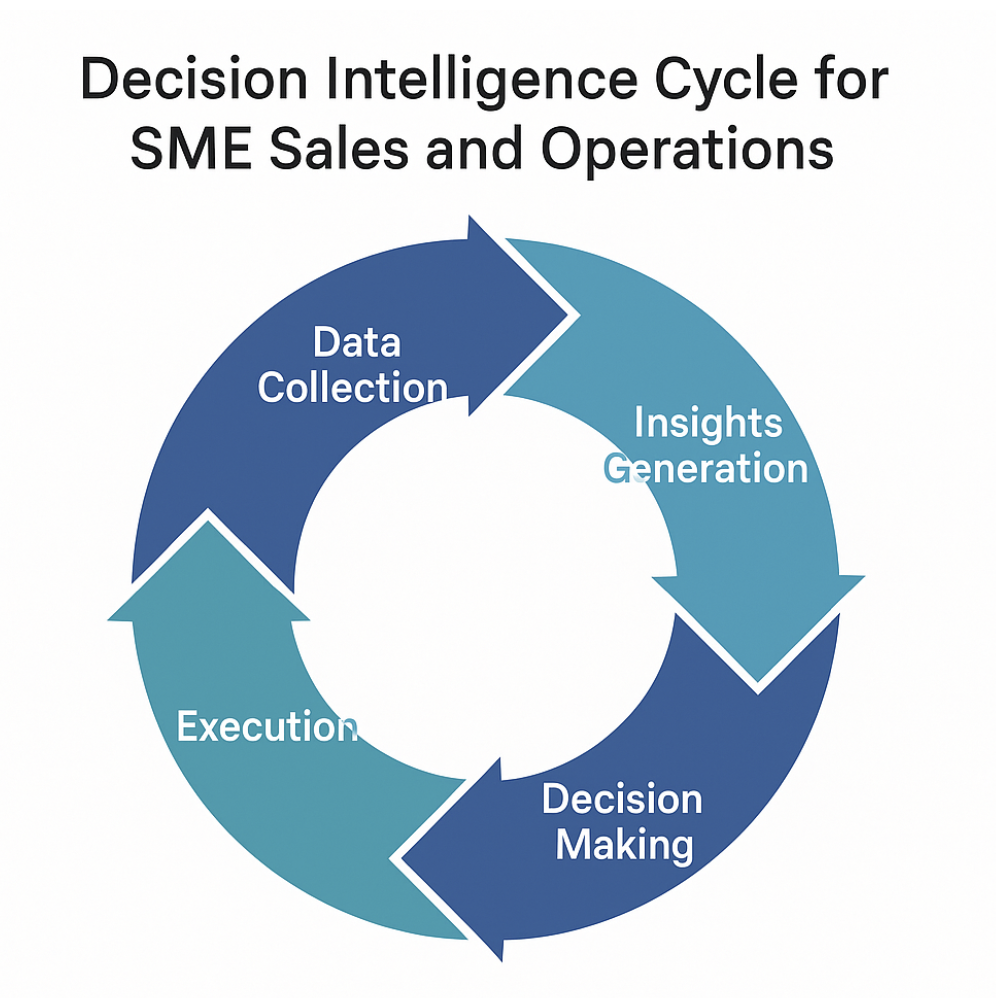In 2025, small and medium-sized businesses are under pressure to make faster, smarter decisions. With rising competition and limited resources, the ability to move quickly without sacrificing accuracy is critical.
That’s where decision intelligence (DI) comes in. It combines data science, artificial intelligence, and decision theory to help businesses make better choices. For SMEs, this means turning raw data into strategic insight without needing a full team of data scientists.
Why Decision Intelligence Matters for SMEs
Decision intelligence gives SMEs a practical way to use AI in daily operations. It improves how teams forecast demand, manage inventory, optimize pricing, and respond to market changes. Instead of relying on gut feeling or spreadsheets, DI enables data-backed, real-time decisions.
The process often follows a structured cycle of data collection, insight generation, decision-making, and execution.

It also helps SMEs:
- Reduce the risk of overstocking or understocking
- Understand customer behavior with more depth
- Predict sales performance accurately
- Cut down delays caused by manual analysis
For a complete strategy, see how AI agents improve workflow automation in SMEs.
Tools Powering Decision Intelligence
Salesforce Einstein
Salesforce's Einstein AI platform now includes generative AI, conversational interfaces, and low-code tools. For SMEs, this means real-time sales forecasting, AI-generated suggestions, and easy deployment without needing an in-house AI team.
Key benefits include:
- Copilot-style interfaces for faster navigation
- Unified customer data across systems
- AI-driven apps that adapt to business logic
IBM Decision Optimization
IBM’s optimization platform allows SMEs to manage inventory, reduce carrying costs, and forecast demand. It calculates reorder points, adjusts safety stock, and considers logistics when making inventory decisions.
Together, these tools remove guesswork and add structure to everyday decisions.
Case Study: Amarra's AI-Powered Inventory and Customer Support
Amarra, a formal gown distributor based in New Jersey, supplies special-occasion dresses to over 800 retailers worldwide. As a fast-growing SME, Amarra faced challenges in managing inventory, scaling customer support, and creating quality content at speed.
Decision Intelligence in Action
To improve decision-making across departments, Amarra implemented a blend of AI tools:
- ChatGPT: Used to generate detailed product descriptions, improving SEO and speeding up content production
- AI Inventory System: Forecasted demand using seasonal and historical sales data
- AI-Powered Chatbots: Handled 70% of customer queries, freeing up the human team for more complex requests
Results
- 60% faster content creation without loss of quality
- 40% reduction in overstock thanks to predictive inventory
- 70% of support inquiries resolved by bots, improving response time and team efficiency
Challenges Overcome
- Tone and Personalization: Initial chatbot responses felt impersonal; refining voice and style helped align them with the brand
- System Integration: Early integration issues were addressed by phased rollouts and targeted staff training
This case highlights how real SMEs are using decision intelligence tools not just to automate, but to optimize operations across customer service, inventory, and content marketing—often alongside drag-and-drop workflow builders.
How to Bring Decision Intelligence into Your SME
- Start with what you have: Look at your sales, inventory, and customer data. Clean it up and make it accessible.
- Pick tools that match your scale: Platforms like Salesforce and IBM offer modular pricing and cloud-based solutions.
- Train your team: Many DI platforms come with intuitive interfaces, but onboarding is still key.
- Monitor results: Measure forecasting accuracy, stock efficiency, and time saved.
To scale even further, see how AI workflow design can connect insights to execution, or how automation tools improve day-to-day efficiency for SMEs.
Conclusion
In 2025, decision intelligence helps level the playing field for SMEs. By using the right tools and processes, small businesses can make faster, more confident decisions without massive overhead. Whether it’s improving forecasting or optimizing stock levels, DI supports smart growth with measurable results.
For more detailed insights and industry-specific applications of decision intelligence, explore our reports page.
FAQs
What’s the difference between business intelligence and decision intelligence?
Business intelligence tells you what happened. Decision intelligence tells you what to do next based on predictive modeling and optimization.
Is it affordable for small businesses?
Yes. Many DI tools offer tiered pricing and low-code features that make implementation realistic for SMEs.
How quickly can I see results?
In areas like inventory or sales forecasting, SMEs often see results within 3 to 6 months.
Do I need a data scientist to use DI tools?
No. Most platforms are designed for non-technical users with guided workflows and prebuilt templates.



